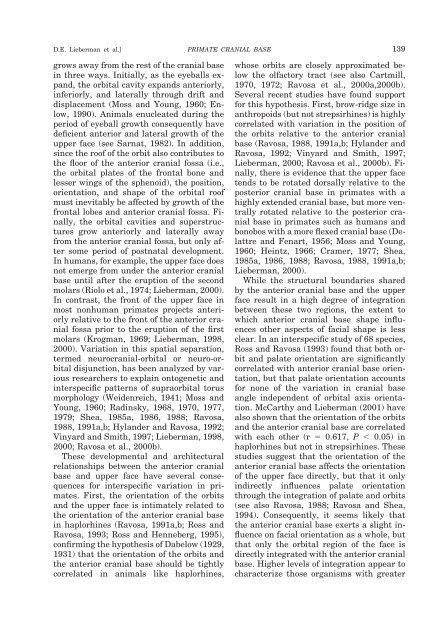The primate cranial base: ontogeny, function and - Harvard University
The primate cranial base: ontogeny, function and - Harvard University
The primate cranial base: ontogeny, function and - Harvard University
You also want an ePaper? Increase the reach of your titles
YUMPU automatically turns print PDFs into web optimized ePapers that Google loves.
D.E. Lieberman et al.]<br />
PRIMATE CRANIAL BASE 139<br />
grows away from the rest of the <strong>cranial</strong> <strong>base</strong><br />
in three ways. Initially, as the eyeballs exp<strong>and</strong>,<br />
the orbital cavity exp<strong>and</strong>s anteriorly,<br />
inferiorly, <strong>and</strong> laterally through drift <strong>and</strong><br />
displacement (Moss <strong>and</strong> Young, 1960; Enlow,<br />
1990). Animals enucleated during the<br />
period of eyeball growth consequently have<br />
deficient anterior <strong>and</strong> lateral growth of the<br />
upper face (see Sarnat, 1982). In addition,<br />
since the roof of the orbit also contributes to<br />
the floor of the anterior <strong>cranial</strong> fossa (i.e.,<br />
the orbital plates of the frontal bone <strong>and</strong><br />
lesser wings of the sphenoid), the position,<br />
orientation, <strong>and</strong> shape of the orbital roof<br />
must inevitably be affected by growth of the<br />
frontal lobes <strong>and</strong> anterior <strong>cranial</strong> fossa. Finally,<br />
the orbital cavities <strong>and</strong> superstructures<br />
grow anteriorly <strong>and</strong> laterally away<br />
from the anterior <strong>cranial</strong> fossa, but only after<br />
some period of postnatal development.<br />
In humans, for example, the upper face does<br />
not emerge from under the anterior <strong>cranial</strong><br />
<strong>base</strong> until after the eruption of the second<br />
molars (Riolo et al., 1974; Lieberman, 2000).<br />
In contrast, the front of the upper face in<br />
most nonhuman <strong>primate</strong>s projects anteriorly<br />
relative to the front of the anterior <strong>cranial</strong><br />
fossa prior to the eruption of the first<br />
molars (Krogman, 1969; Lieberman, 1998,<br />
2000). Variation in this spatial separation,<br />
termed neuro<strong>cranial</strong>-orbital or neuro-orbital<br />
disjunction, has been analyzed by various<br />
researchers to explain ontogenetic <strong>and</strong><br />
interspecific patterns of supraorbital torus<br />
morphology (Weidenreich, 1941; Moss <strong>and</strong><br />
Young, 1960; Radinsky, 1968, 1970, 1977,<br />
1979; Shea, 1985a, 1986, 1988; Ravosa,<br />
1988, 1991a,b; Hyl<strong>and</strong>er <strong>and</strong> Ravosa, 1992;<br />
Vinyard <strong>and</strong> Smith, 1997; Lieberman, 1998,<br />
2000; Ravosa et al., 2000b).<br />
<strong>The</strong>se developmental <strong>and</strong> architectural<br />
relationships between the anterior <strong>cranial</strong><br />
<strong>base</strong> <strong>and</strong> upper face have several consequences<br />
for interspecific variation in <strong>primate</strong>s.<br />
First, the orientation of the orbits<br />
<strong>and</strong> the upper face is intimately related to<br />
the orientation of the anterior <strong>cranial</strong> <strong>base</strong><br />
in haplorhines (Ravosa, 1991a,b; Ross <strong>and</strong><br />
Ravosa, 1993; Ross <strong>and</strong> Henneberg, 1995),<br />
confirming the hypothesis of Dabelow (1929,<br />
1931) that the orientation of the orbits <strong>and</strong><br />
the anterior <strong>cranial</strong> <strong>base</strong> should be tightly<br />
correlated in animals like haplorhines,<br />
whose orbits are closely approximated below<br />
the olfactory tract (see also Cartmill,<br />
1970, 1972; Ravosa et al., 2000a,2000b).<br />
Several recent studies have found support<br />
for this hypothesis. First, brow-ridge size in<br />
anthropoids (but not strepsirhines) is highly<br />
correlated with variation in the position of<br />
the orbits relative to the anterior <strong>cranial</strong><br />
<strong>base</strong> (Ravosa, 1988, 1991a,b; Hyl<strong>and</strong>er <strong>and</strong><br />
Ravosa, 1992; Vinyard <strong>and</strong> Smith, 1997;<br />
Lieberman, 2000; Ravosa et al., 2000b). Finally,<br />
there is evidence that the upper face<br />
tends to be rotated dorsally relative to the<br />
posterior <strong>cranial</strong> <strong>base</strong> in <strong>primate</strong>s with a<br />
highly extended <strong>cranial</strong> <strong>base</strong>, but more ventrally<br />
rotated relative to the posterior <strong>cranial</strong><br />
<strong>base</strong> in <strong>primate</strong>s such as humans <strong>and</strong><br />
bonobos with a more flexed <strong>cranial</strong> <strong>base</strong> (Delattre<br />
<strong>and</strong> Fenart, 1956; Moss <strong>and</strong> Young,<br />
1960; Heintz, 1966; Cramer, 1977; Shea,<br />
1985a, 1986, 1988; Ravosa, 1988, 1991a,b;<br />
Lieberman, 2000).<br />
While the structural boundaries shared<br />
by the anterior <strong>cranial</strong> <strong>base</strong> <strong>and</strong> the upper<br />
face result in a high degree of integration<br />
between these two regions, the extent to<br />
which anterior <strong>cranial</strong> <strong>base</strong> shape influences<br />
other aspects of facial shape is less<br />
clear. In an interspecific study of 68 species,<br />
Ross <strong>and</strong> Ravosa (1993) found that both orbit<br />
<strong>and</strong> palate orientation are significantly<br />
correlated with anterior <strong>cranial</strong> <strong>base</strong> orientation,<br />
but that palate orientation accounts<br />
for none of the variation in <strong>cranial</strong> <strong>base</strong><br />
angle independent of orbital axis orientation.<br />
McCarthy <strong>and</strong> Lieberman (2001) have<br />
also shown that the orientation of the orbits<br />
<strong>and</strong> the anterior <strong>cranial</strong> <strong>base</strong> are correlated<br />
with each other (r 0.617, P 0.05) in<br />
haplorhines but not in strepsirhines. <strong>The</strong>se<br />
studies suggest that the orientation of the<br />
anterior <strong>cranial</strong> <strong>base</strong> affects the orientation<br />
of the upper face directly, but that it only<br />
indirectly influences palate orientation<br />
through the integration of palate <strong>and</strong> orbits<br />
(see also Ravosa, 1988; Ravosa <strong>and</strong> Shea,<br />
1994). Consequently, it seems likely that<br />
the anterior <strong>cranial</strong> <strong>base</strong> exerts a slight influence<br />
on facial orientation as a whole, but<br />
that only the orbital region of the face is<br />
directly integrated with the anterior <strong>cranial</strong><br />
<strong>base</strong>. Higher levels of integration appear to<br />
characterize those organisms with greater
















